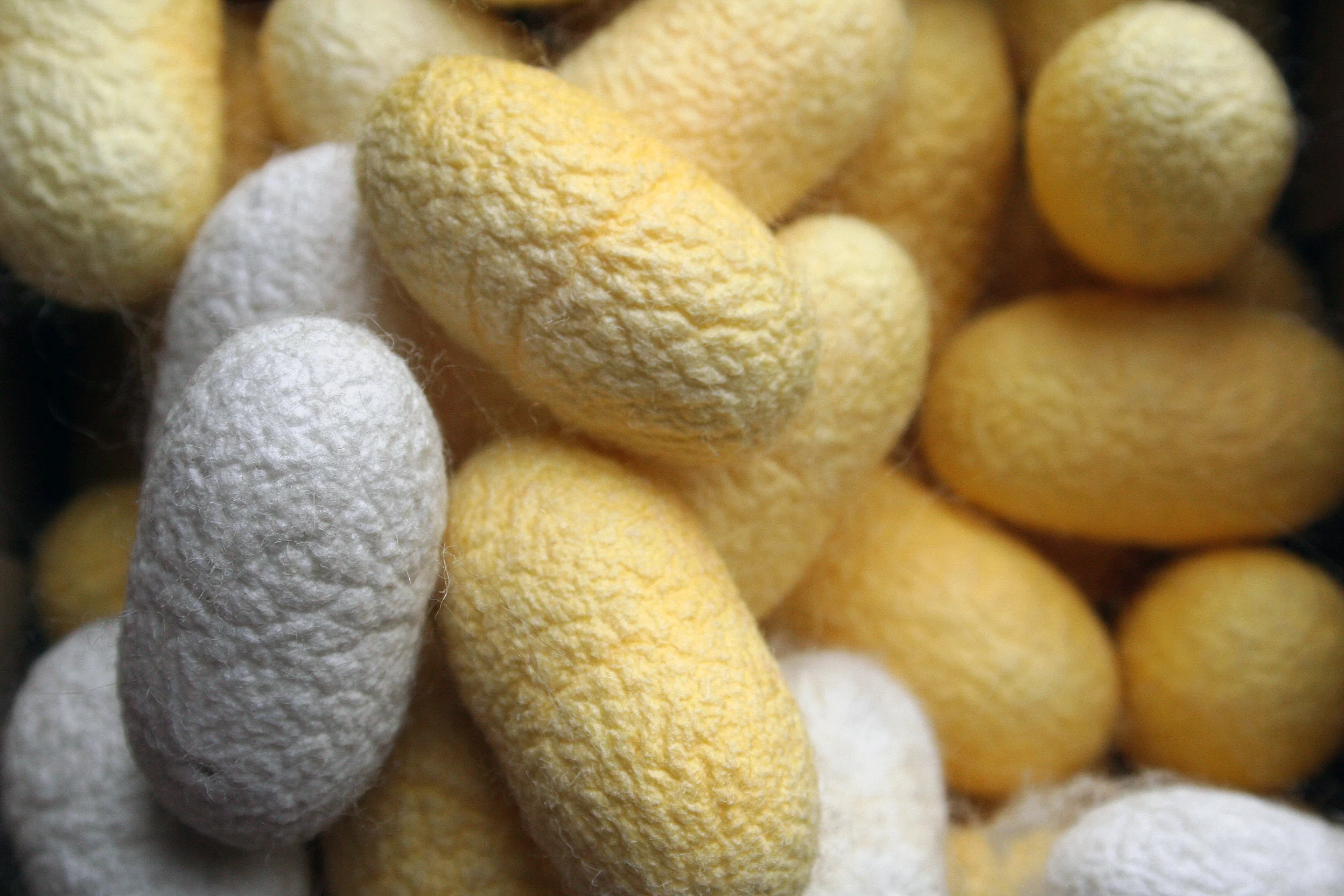Although now closed, Lullingstone Silk Farm was established by Lady Zoe Hart Dyke, Tom Hart Dyke's paternal grandmother, in the early 1930s and was the country's first such farm. She began the enterprise at Lullingstone Castle, later moving to Ayot St. Lawrence in Hertfordshire in 1956, and was credited with reviving the 'art of sericulture' in the UK. A childhood passion became a flourishing business, producing silk for Queen Elizabeth's (the late Queen Mother) coronation robes in 1937, for the current Queen's wedding dress in 1947 and for the robes in her subsequent coronation in 1953. Silk was also used in parachutes during the second world war. Fortunately Lady Zoe imported her silkworms from China - it would have been considered unpatriotic had Italian silkworms, so soon after WW2, been used for royal occasions.
Lady Zoe ran quite an operation - some 30 rooms of the House were taken over to breed hundreds of thousands of silkworms and more than 20 acres of the estate were populated by mulberry bushes to feed them - they were fed white mulberry (Morus Alba) leaves. Each silkworm's cocoon produced 1/4 mile of silk! Tom Hart Dyke's paternal grandfather Sir Oliver also designed, produced and installed machines to reel the cocoons - 'power' reelers - which were then manufactured for export. The main picture above are silkworm cocoons which form part of a display of the Silk Farm's history at Lullingstone Castle and Lady Zoe's son, Guy Hart Dyke, helped out on the Farm in November 1947, with forewoman Mabel Standen. Guy says "I was asked to help out but I didn't last very long - I wasn't very good at it! I remember the smell and the rustle of the worms, munching the mulberry leaves. You also had to be careful not to slam the doors - the draught could kill them".
In 1947 the Farm was commissioned to produce silk for an altar frontal for the Church of St Botolph, which now hangs in Queen Anne's bedroom in the House for visitors to see. The Silk Farm later produced silk for the late Princess Diana's wedding dress but by that time, the Farm had been sold and moved to Dorset.
Queen Mary visited Lullingstone to see the Silk Farm in 1936 and then Princess Elizabeth and the Duke of Edinburgh inspecting Lullingstone's silk reels at the Ideal Home exhibition in 1948.
There are video archives available on-line documenting different aspects of the Silk Farm's work. Watch here for Lady Zoe feeding the silkworms, and here for the traditional silkworm blessing ceremony at the beginning of the season, taking place in St Botolph's Church at Lullingstone. In 1937 Lady Zoe was also interviewed by Time magazine: read here. Lady Zoe is author of So Spins the Silkworm (1949). In 1953 a rather unusual party, involving llamas, was put on to celebrate the silkfarm's successes - watch here. Interviews with Guy Hart Dyke about the Silk Farm were broadcast on the day of the Royal Wedding in April 2011 on the BBC's The One Show as well as the day before in 'When Royals Wed', on BBC1.
At Lullingstone we have displays documenting the history of the Silk Farm, including various memorabilia.
Memories from the Silk Farm:
Sir Mick Jagger, then based in Dartford, recalled visiting the Silk Farm as a young boy. "There was such an awful smell!"
Others have said:
"I can remember the silk farm – as a child from South East London I remember coming to the country – a big treat in itself – with the Girls Life Brigade. We were all fascinated with the worms on the mulberry leaves and especially seeing a real castle it was a thrilling day for all of us. I reminisced when I read about the silk and the royal weddings in the past – it would be wonderful to see the silkworms in production today".
"I lived in Kent as a child and we came on a school visit to see the silk production, around the time of the Coronation of Elizabeth II, I would think, in 1953. I remember a number of women, working very fast, wearing turban-style headscarves, splashing water and the NOISE. Probably against 'Health and Safety' these days. The lady guide had to shout so that we could hear her".
"I remember being surprised to find two gas marks at the entrance to the House - I was desperate to try one on. They had been put out in case anyone couldn't stand the smell of the silkworms. The smell was quite terrible!"
"We were allowed to buy a cocoon and I did, keeping it in the hot water cupboard. My mother was not amused when she was sweeping up caterpillars that were going down the stairs".
Related articles
Royal weddings past from 1795 to 1981, The Telegraph, 24th Apr 2011
The Queen's birthday - 85 facts you should know about The Queen, The Telegraph, 22nd Apr 2011
Dartford’s royal silk producers rue the end of a unique production line, Dartford & Swanley Times, 5th Jan 2011
Closure of English silk farm will force a material change for next royal wedding, The Times, 4th Jan 2011
Queen's wedding dress restored for unique show, The Telegraph, 27th April 2002
A sale as smooth as silk, The Telegraph, 20th March 2004
BBC South East, Interview with Guy Hart Dyke - Silk Farms, 27th October 2016
Science: Lady's Worms, Time, 4th Jan 1937
